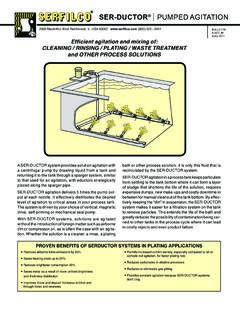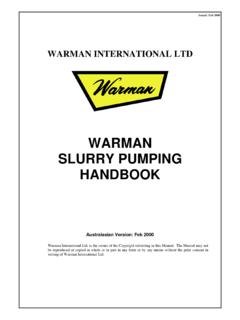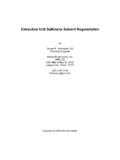Transcription of Parker Vent Master™ - iTEMS™
1 Parker Vent Master Process Analyzer Vent-Header Pressure Control SystemCatalog 4142-VM February 2014iiParker Hannifin CorporationInstrumentation Products DivisionJacksonville, AL 4142-VM1 Parker Hannifin CorporationInstrumentation Products DivisionJacksonville, AL 4142-VMTable of Contents Copyright 2014 Parker Hannifin Corporation. All Rights ..PageParker Vent Master Introduction ..2 Functional Options ..3 Parker Vent Master Eductor (-EDR) Model Theory of Operation ..4-5 Eductor Motive Force / Return Point Back Pressure / Flow Curves ..6 Nitrogen (-EDR) Model Installation and Startup Procedures ..7 Eductor Natural Gas (-EDRNB) Model Installation and Startup Procedures ..8 Parker Vent Master Pump (-PMP) Model Theory of Operation ..19 Pump Model Installation and Startup Procedures ..10 Parker Vent Master No Pump or Eductor (-NPE) Model Theory of Operation.
2 11 No Pump or Eductor Model Installation and Startup Procedures ..12 Dimensions ..13 How to Order ..13 Specifications ..13 Conversions ..14 Safety & Maintenance ..15 Offer of Sale ..16 Parker 's Motion & Control Technologies ..inside back coverOffer of SaleThe items described in this document are hereby offered for sale by Parker -Hannifin Corporation, its subsidiaries or its authorized distributors. This offer and its acceptance are governed by the provisions stated in the detailed Offer of Sale elsewhere in this document or available at USER RESPONSIBILITYFAILURE OR IMPROPER SELECTION OR IMPROPER USE OF THE PRODUCTS DESCRIBED HEREIN OR RELATED ITEMS CAN CAUSE DEATH, PERSONAL INJURY AND PROPERTY document and other information from Parker -Hannifin Corporation, its subsidiaries and authorized distributors provide product or system options for further investigation by users having technical expertise.
3 The user, through its own analysis and testing, is solely responsible for making the final selection of the system and components and assuring that all performance, endurance, maintenance, safety and warning requirements of the application are met. The user must analyze all aspects of the application, follow applicable industry standards, and follow the information concerning the product in the current product catalog and in any other materials provided from Parker or its subsidiaries or authorized the extent that Parker or its subsidiaries or authorized distributors provide component or system options based upon data or specifications provided by the user, the user is responsible for determining that such data and specifications are suitable and sufficient for all applications and reasonably foreseeable uses of the components or Hannifin CorporationInstrumentation Products DivisionJacksonville, AL 4142-VMParker Vent Master Image courtesy of ABBI ntroductionAfter a process sample stream is analyzed, it must be disposed of in a manner consistent with environmental regulations.
4 Today, as in the past, it has been common practice to simply vent the sample stream to the atmosphere. As environmental regulations become more stringent, it is becoming undesirable, if not illegal, to admit these samples to the an analyzer to operate correctly, it must be calibrated and operated under the same conditions. These critical conditions are temperature, flow and pressure, with the pressure of the measurement cell being the most critical. Venting analyzer effluent to atmosphere is not only convenient, but it also provides a very stable reference pressure for the analyzer measurement cell. In other words, the measurement cell floats on atmospheric outlet sample streams are traditionally collected into a closed vent header. This vent header either flows to atmosphere or back to the process. When atmospheric venting is not allowed, the most common disposal point is the plant flare where the analyte sample stream is burned.
5 However, the flare header is subject to pressure variations as high as 20 psig or more as process upsets create backpressure. When venting an analyzer into the flare collection system, the measurement cell floats on these varying pressures. If this condition is left unchecked these pressure fluctuations will result in significant analyzer measurement errors. The primary function of the Parker Vent Master is to isolate the analyzer from fluctuating outlet pressures by controlling the pressure of the collection header (commonly referred to as the Vent Header) and pumping the effluent sample gases into the fluctuating return system. 3 Parker Hannifin CorporationInstrumentation Products DivisionJacksonville, AL 4142-VMParker Vent Master Functional OptionsThe Parker Vent Master can be configured to perform in several different applications as outlined in the following nomenclature summary.
6 The Eductor model (EDR) is the most common and is used when disposing analyzer effluent gasses to a flare system. The -EDR model requires a bulk nitrogen source to provide the necessary motive force for the eductor. The Eductor Natural Gas model (EDRNB) is very similar to the -EDR but it incorporates non-bleed pneumatic circuitry that enables the use of fuel gas as the motive force for the eductor. The pump (PMP) model is most commonly used when returning analyzer effluent to the process, or any other point with a return pressure above 20 psig. In this case a positive displacement pump (provided by others) is utilized. The model with no pump or eductor (NPE) is used when an external plant vacuum system is available. All configurations of the Parker Vent Master provide exceptional pressure stability in the analyzer effluent vent header regardless of upstream flow and downstream pressure fluctuations as detailed below:4 Parker Hannifin CorporationInstrumentation Products DivisionJacksonville, AL 4142-VMParker Vent Master Parker Vent Master Eductor (-EDR) Model Theory of OperationThis system is comprised of regulators, gauges, a rotameter, a controller and an eductor mounted in a small enclosure for ease of operation and installation.
7 A low-pressure regulator (PR-1) with a large sensitive diaphragm is also included with the system but is mounted directly onto the vent header as shown on the schematic below and layout drawing on page 7. The eductor flow capacity dictates the Vent Master s maximum analyzer effluent flow capacity. Parker Vent Master EDR models have a wide range of analyte flow, return point back pressure and motive force Hannifin CorporationInstrumentation Products DivisionJacksonville, AL 4142-VMParker Vent Master PR-1 is the vent header pressure controller. Its function is to constantly flow a Nitrogen makeup gas into the vent header, sufficient to maintain a constant pressure. While each analyzer will vent effluent gas into the vent header by varying amounts, PR-1 will sense the header pressure and provide Nitrogen to makeup the difference necessary to maintain a stable +1" WC pressure.
8 Simultaneously, the Parker Vent Master eductor will pump a constant analyzer effluent and Nitrogen makeup mixture from the Vent Header. For example, if the Vent Header Flow Adjustment (FI-1) is set at 14 SLPM and the analyzers are venting a total of 12 SLPM into the vent header, PR-1 will supply 2 SLPM of Nitrogen. The flow capacity limiting component in the Parker Vent Master is the eductor. The Parker Vent Master is available with three different eductor capacities as outlined on the performance curves on page 6. In all cases, test results show that the Vent Header pressure will be maintained to within Note: The standard PR-1 incorporates an internal relief valve on its diaphragm. The relief valve will only open when the Vent Header pressure exceeds 7" WC. The threaded vent port on the dome of the PR-1 regulator must be vented to a safe area and MUST be maintained at atmospheric pressure.
9 ANY pressure change in the regulators dome connection will be reflected in the Vent Header. Consult factory for a PR-1 without a relief is the normal makeup and motive force gas used to drive the eductor because it is inert. In cases where Nitrogen is not desirable, Natural Gas can also be used to drive the eductor into a flare system or any other gas that is compatible with the process. In this case, the -EDRNB should be " WC pressure variation over the flow capacity range of each Parker Vent Master incorporates a Nitrogen Economizer Circuit which throttles the eductor s motive force flow necessary to maintain a constant 6" Hg vacuum. This circuit conserves Nitrogen use and reduces the normal motive pressure eductor supply to approximately 20 psig, with an eductor return point back pressure of 1 psig. As the eductor s back pressure increases (caused by increasing flare header pressures) the vacuum created by the eductor will be reduced.
10 The Economizer Circuit vacuum controller monitors the eductor s vacuum and automatically adjusts the motive force flow to the eductor accordingly to maintain a constant differential pressure necessary to facilitate a constant flow rate from the Vent Header. The motive force Nitrogen flow rate can vary from 3 to 9 SCFM depending upon the return point back pressure of the eductor as outlined in the Nitrogen Motive Force Consumption chart below. Parker Vent Master Eductor Model Theory of Operation (Continued)6 Parker Hannifin CorporationInstrumentation Products DivisionJacksonville, AL 4142-VMParker Vent Master Parker Vent Master Eductor Motive Force / Return Point Back Pressure / Flow CurvesThe -EDR version of the Vent Master is available with three different eductor capacities. Proper eductor sizing is based on three critical system variables: Motive force pressure availability Maximum analyte flow from the Vent Header Maximum return point back pressureUse the graphs at the right to determine the proper eductor size for an application.





